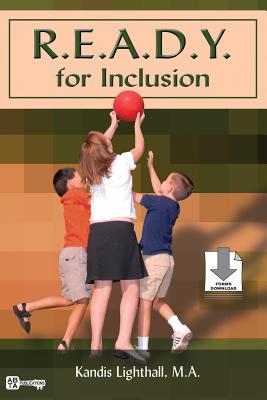R.E.A.D.Y. for Inclusion

R.E.A.D.Y. for Inclusion
The purpose of this manual is to address the need of educational teams to develop appropriate least restrictive environments in general education settings. The manual provides systematic and quantifiable tools which will allow the educational teams to evaluate their own philosophy, environments, individual student needs, as well as, individual staff and peer support.It is often the lack of "readiness" that results in frustration for administrators, educators, parents, and most of all, the students. Careful planning and preparation is critical when placing a student with a disability in the least restrictive environment or "inclusive" setting. Frequently only observation is used to prepare for the inclusive placement. This manual offers educators informal tools to quantifiably evaluate inclusive settings and supports. Although all these tools were originally developed for students with an Autism Spectrum Disorder they have been proven effective with student who have other disabilities.Chapter 1 provides the reader with a protocol for developing a shared vision between school staff. It is very important that the school community share the same understanding of least restrictive environment or "inclusion" and all that it entails. Activities and suggestions for staff awareness are outlined.The following five chapters address the acronym R.E.A.D.Y. from the title.Chapter 2 addresses the R. by providing a checklist to evaluate the "readiness" of the student with disabilities to participate as a student in the inclusive setting. The checklist determines the expectations for an average student and then determines what skills require additional instruction, accommodations, and/or modifications for successful participation. It also offers instructional strategies and curricular suggestions.Chapter 3 discusses E. which stands for the "environment" for instruction. A checklist called the V.E.S.T. is presented to evaluate the "environment" for instruction. The acronym represents the four areas that are necessary for optimizing learning for students with Autism Spectrum Disorders and other related attention and learning disabilities. General education teachers report that by systematically addressing these ecological factors, students with other learning differences such as ADD and ADHA have demonstrated improvements in their abilities to attend and participate in instruction.In Chapter 4 A. explains "accommodating" for academic and learning difference. Accommodatio
PRP: 278.94 Lei
Acesta este Pretul Recomandat de Producator. Pretul de vanzare al produsului este afisat mai jos.
251.05Lei
251.05Lei
278.94 LeiLivrare in 2-4 saptamani
Descrierea produsului
The purpose of this manual is to address the need of educational teams to develop appropriate least restrictive environments in general education settings. The manual provides systematic and quantifiable tools which will allow the educational teams to evaluate their own philosophy, environments, individual student needs, as well as, individual staff and peer support.It is often the lack of "readiness" that results in frustration for administrators, educators, parents, and most of all, the students. Careful planning and preparation is critical when placing a student with a disability in the least restrictive environment or "inclusive" setting. Frequently only observation is used to prepare for the inclusive placement. This manual offers educators informal tools to quantifiably evaluate inclusive settings and supports. Although all these tools were originally developed for students with an Autism Spectrum Disorder they have been proven effective with student who have other disabilities.Chapter 1 provides the reader with a protocol for developing a shared vision between school staff. It is very important that the school community share the same understanding of least restrictive environment or "inclusion" and all that it entails. Activities and suggestions for staff awareness are outlined.The following five chapters address the acronym R.E.A.D.Y. from the title.Chapter 2 addresses the R. by providing a checklist to evaluate the "readiness" of the student with disabilities to participate as a student in the inclusive setting. The checklist determines the expectations for an average student and then determines what skills require additional instruction, accommodations, and/or modifications for successful participation. It also offers instructional strategies and curricular suggestions.Chapter 3 discusses E. which stands for the "environment" for instruction. A checklist called the V.E.S.T. is presented to evaluate the "environment" for instruction. The acronym represents the four areas that are necessary for optimizing learning for students with Autism Spectrum Disorders and other related attention and learning disabilities. General education teachers report that by systematically addressing these ecological factors, students with other learning differences such as ADD and ADHA have demonstrated improvements in their abilities to attend and participate in instruction.In Chapter 4 A. explains "accommodating" for academic and learning difference. Accommodatio
Detaliile produsului









